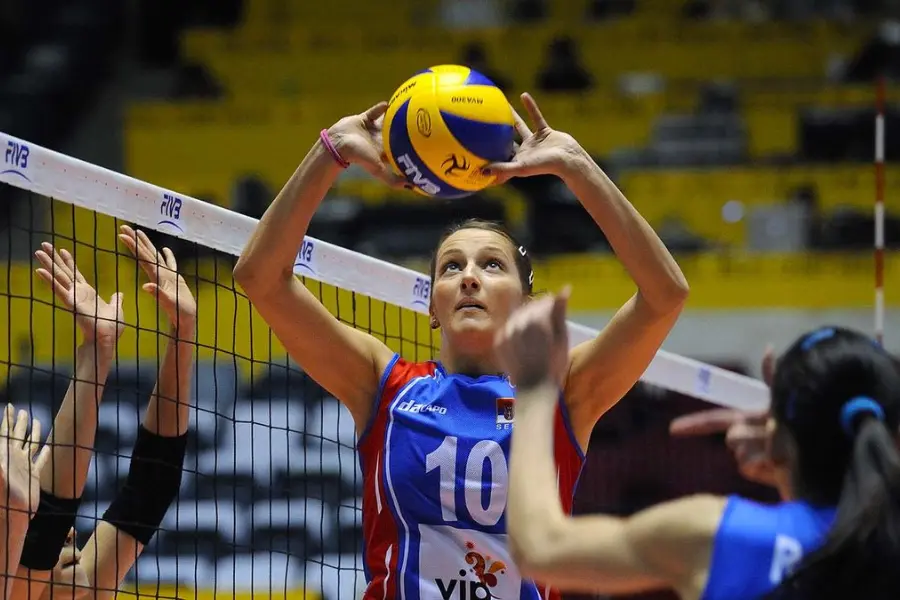Every volleyball team needs a really good, consistent setting. It is ideal to touch the ball again after it crosses the net after the set. Hopefully, it will be a hit (or spike) after the first pass (sometimes called a bump).
It is common for casual fans to think that setting is just like volleying and everyone is capable of it. Running the offense is really a specialized skill for a setter, who is like the quarterback of the volleyball team.
When it comes to setting volleyballs, how do beginners learn? To learn how to set well, follow these four steps:
How to Set a Volleyball?

An athlete sets up a spike for another player by quickly making contact with the ball. Most good spikes are the result of a good set, that is, a set that follows volleyball’s rules against catching the ball and is predictable and easy to execute by the attacker.
To make a good setting, the overall style must be consistent. Although the maneuver itself is simple, mastering it can be challenging.
Step 1: Getting to the Ball
- Make sure you read the defense. Plan where you want the ball to go before the ball is served. Does one of their blockers perform better than the other? What’s the obvious area they’re not guarding well? To take advantage of that weakness, you want to pass the ball to an attacker on your team who is positioned to make the most of it.
- When you have the opportunity, you should constantly assess the defense, so that you know where to send the ball.
- Prepare to move. You should stand with your weight on your right foot while waiting for the ball to be passed, and then take a step with your left foot in the direction of the ball.
- In most instances, setters prefer to approach each set from the back-right corner of the court. The most effective way to send the ball to your team’s attackers is to start your set from wherever is most comfortable for you.
- Get to the ball as soon as possible. Rarely will you be able to catch the ball directly. The quicker you reach it, the more time you have to complete the set.
- It’s all about efficiency when it comes to getting to the ball quickly. Take as few steps as necessary in order to reach the ball in a straight line.
- Running efficiently is also important. Running with your arms up is a mistake made by many setters. You should wait until you are in position before raising your arms.
- Make sure your body is square to the target. Be sure to face the spot where the ball will come down when you reach your position, not the direction it came from.
- The best way to set the ball is to always orient yourself toward the left antennae, that way the other team can’t determine where you’re going to set it.
Step 2: Getting in Position
- Raise your arms above your head. Your elbows should be pointed to the sides and your hands should be directly above your forehead.
- Place your hands in the appropriate position. With your fingers spread out, as if someone were about to rest the ball in your hands, place your hands four to six inches above your forehead.
- You should be able to see the ball through the triangular window formed by your thumbs and forefingers, but your hands should not touch each other.
- Before you contact the ball, try to relax your fingers.
- Rather than extending your arms in front or directly above you, extend them upwards and behind if you want to back set the ball.
- Put your feet in the right place. Place your feet about shoulder width apart, with your closest foot slightly in front of your other foot. It prevents the set from accidentally going over the net by rotating your hips and shoulders into the court.
- Kneel down. As you set, you should bend your knees slightly and distribute your weight evenly between your balls and arches.
- If necessary, you will be able to rapidly change the direction you are facing if you have an even distribution of weight.
- Knee bends are less important when back setting. Your back should be slightly arched as well as your hips pushed forward a bit.
Step 3: Setting the Ball
- Choosing an attacker is your last chance to decide where to send the ball. You have already developed some ideas, but this is your last chance to make the right choice.
- By being deceptive about where you intend to send the ball, you can create advantageous situations for your team and leave the other team unprepared for which attacker will spike.
- In the last second, you may decide to set the ball forward rather than backset, or vice versa, by slightly arching your back.
- Alternatively, you can square up as if you will set the ball toward a specific player across the court and then hit a short pass off to your side if that is what you want to do.
- Look toward the final destination of the ball after setting it, to signal your teammates.
- Contact each other. Just above your hairline, you should make contact with the ball.
- Your fingers should be in contact with the ball at all times. In order to control a ball, you need to make contact with as much surface area as possible.
- Make sure the ball does not touch your palms. When your palms contact the ball, it is considered catching, which is against volleyball rules.
- Your team might lose a point if the referee decides to restart the rally due to an illegal maneuver.
- Strive to push upwards. Push the ball upward in the direction of the spiker as soon as the ball touches your fingers.
- Your legs send power through your body to your hands when you straighten them. The push should involve your entire body.
- Ideally, the ball should be in contact with the player for a short period of time.
- Essentially, this is the same as a back set, but the knees provide less force.
- Make sure you follow through. Your arms should be fully extended at the end of your set, and you should straighten your wrists after releasing the ball. In this way, you can ensure that the trajectory stays on track.
You may enjoy reading Rally Scoring In Volleyball
How Do You Set a Volleyball Without Spin?

Some referees may call for double hits if the ball is set without spin. Gameplay won’t be affected by spin.
It doesn’t matter how much spin was on the ball when the hitter struck it. There are two things you need to practice in order to set the ball without spin:
- Starting from a stable and calm place is essential. You know what happens if you stretch, fly through the air, and lean to one side when you set? You’ll end up with a crazy set. It will be easier to control the ball if you are in position, keep your body in control, and push through your set.
- Keep your wrists flicking and your push in focus. Having strong fingers allows you to push the ball far enough so that it gets to your hitter’s position, and flicking your wrists fast enough so that the ball is delivered very quickly to the hitter so they don’t have to wait.
Do I Volley With Soft Fingers or Strong Fingers?
The ball needs to be absorbed and cared for by loose, flexible hands. While doing this, your fingers must be strong and force the ball to go where you want.
When receiving, imagine your fingers being relaxed and flexible, but as you are finishing, imagine them strong and firm.
Is the Setter Always the Shortest Player On the Team?
Most often, the setter is the shortest player on the team, but that’s not always the case. Being a tall setter can actually be an advantage for your team.
Having the height or vertical to block adds to the defense, especially if the setter is constantly around the net. Setters should not always be the shortest players on a team, but that’s not a rule that should always be followed.
Setting Drills

The number of good setting drills is endless. For beginners, here are a few suggestions:
The Cone and Tennis Ball
When the ball crosses the net, the player should be in the “ready” position. It is recommended that the player holds a small cone in their hand.
It is simulated by tossing a tennis ball into the air high into the air by a coach, teammate, or parent. Under the tennis ball, the setter runs in position, catches the tennis ball in the cone, and holds the ball over their forehead.
Positioning is emphasized in this drill. Make sure your footwork, tracking, and speed are good.
Freeze the Set
A coach or mentor throws the ball to the setter, who catches it but freezes.
Coaching involves looking at how the hands are placed, how the body is positioned, and how the form is applied. As you practice maintaining good form, gradually increase the difficulty of the toss.
After intense practice, this drill provides a nice change of pace because it allows players to identify good form and how their form may be deteriorating.
Seated Setting
Several feet apart, have two players sit cross-legged. Placed in this seated position, they are facing each other. Is it possible for them to volley back and forth consistently without losing control? Distance between the partners should be gradually increased.
You may enjoy reading What Does Mh Mean In Volleyball?
What is a Quickset in Volleyball?
The quick set is a type of advanced set that is fast and straight to the hitter, requiring less arc. As a weapon against the other team, they are used to surprise them.
Blockers have a difficult time reacting and getting to the net in time to compete for the ball because the timing is so different. The other team will get a free ball if you do a quick set and the hitter misses, so you need taller, more athletic hitters.
Frequently Asked Questions
How often should I practice volleyball setting drills?
The key to success is regular practice. If you wish to see significant improvement in your skills, aim for three dedicated setting sessions per week.
Can I learn volleyball setting on my own, or do I need a coach?
The guidance and feedback that a coach provides is invaluable, even though self-practice is beneficial. Optimal results can be achieved by combining individual practice and coaching sessions.
What is the most challenging aspect of volleyball setting?
Intuition and technique must be balanced. Finding the right balance between structured play and spontaneous decision-making requires continual practice.
Are there specific drills to improve setting accuracy under pressure?
Your drills should include pressure situations. Practice helps you improve your setting accuracy during critical moments by simulating game scenarios.
How can I improve communication with my teammates during setting plays?
Improve your non-verbal and verbal communication skills. To communicate effectively in a setting, you need to establish clear signals and understand the cues of your teammates.
Conclusion
As a result, mastering volleyball setting requires technical proficiency, mental resilience, and effective communication. Your setting skills can be elevated to new heights if you embrace the dynamic nature of the game, practice diligently, and understand the fundamentals.
Get on the court, practice, and look forward to your setting transforming into a game-changing asset.
You may enjoy reading Grass Volleyball Rules





